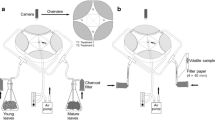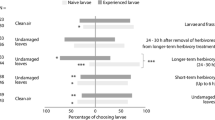Abstract
Herbivore-induced plant volatiles have been reported to play a role in the host-searching behavior of herbivores. However, next to nothing is known about the effect of volatiles emitted from tea plants infested by Ectropis obliqua larvae on the behavior of conspecific adults. Here, we found that tea plants infested by E. obliqua caterpillars for 24 h were more attractive to both virgin male and female E. obliqua adults than were intact, uninfested tea plants; moreover, mated female E. obliqua moths were more attracted by infested tea plants and preferentially oviposited on these plants, whereas male moths were repelled by infested plants once they had mated. Volatile analysis revealed that the herbivore infestation dramatically increased the emission of volatiles. Among these volatiles, 17 compounds elicited antennal responses from both male and female virginal moths. Using a Y-tube olfactometer, we found that 3 of the 17 chemicals, benzyl alcohol, (Z)-3-hexenyl hexanoate, and (Z)-3-hexenal, were attractive, but two compounds, linalool and benzyl nitril, were repellent to virgin male and female moths. One chemical, (Z)-3-hexenyl acetate, was attractive only to virgin males. Mated females were attracted by three compounds, (Z)-3-hexenyl hexanoate, (Z)-3-hexenyl acetate, and (Z)-3-hexenal; whereas mated males were repelled by (Z)-3-hexenol. The findings provide new insights into the interaction between tea plants and the herbivores, and may help scientists develop new measures with which to control E. obliqua.





Similar content being viewed by others
References
Arab A, Trigo JR, Lourencão AL, Peixoto AM, Ramos F, Bento JMS (2007) Differential attractiveness of potato tuber volatiles to Phthorimaea operculella (Gelechiidae) and the predator Orius insidiosus (Anthocoridae). J Chem Ecol 33:1845–1855
Baur R, Košűál V, Städler E (1996) Root damage by conspecific larvae induces preference for oviposition in cabbage root flies (Delia radicum, Anthomyiidae). Entomol Exp Appl 80:224–227
Chen YG, Huang MD (2001) Biological control progress of Ectropis obliqua Prout. J Environ Entomol l 23:181–184
De Moraes CM, LEWIS WJ, Pare PW, Alborn HT, Tumlinson JH (1998) Herbivore infested plants selectively attract parasitoids. Nature 393:570–573
De Moraes CM, Mescher MC, Tumlinson JH (2001) Caterpillar induced nocturnal plant volatiles repel conspecific females. Nature 410:577–580
Dicke M, Sabelis MW (1988) How plants obtain predatory mites as bodyguards. Neth J Zool 38:148–165
Dicke M, van Loon JJA (2000) Multitrophic effects of herbivore-induced plant volatiles in an evolutionary context. Entomol Exp Appl 97:237–249
Frati F, Salerno G, Conti E, Bin F (2008) Role of the plant – conspecific complex in host location and intra-specific communication of Lygus rugulipennis. Physiol Entomol 33:129–137
Han BY, Chen ZM (2002) Behavioral and electrophysiological responses of natural enemies to synomones from tea shoots and kairomones from tea aphids, Toxoptera aurantii. J Chem Ecol 28:2203–2219
Holling CS (1965) The functional response of predators to prey density and its role in mimicry and population regulation. Mem Entomol Soc Can 45:3–60
Hu, C., Zhu, J.Q., Ye, G.Y., Hong, J. (1994). Ectropis Obliqua Prout, a serious geometrid pest of tea bush in east China. Shanghai Scientific and Technical Publishers. 1–217
Iyengar VK, Eisner T (1999) Female choice increases offspring fitness in an arctiid moth (Utetheisa ornatrix). Proc Natl Acad Sci U S A 96:15013–15016
Karban R, Baldwin IT (1997) Induced responses to herbivory. The University of Chicago Press, Chicago
Kessler A, Baldwin IT (2001) Defensive function of herbivore-induced plant volatile emissions in nature. Science 291:2141–2144
Kugimiya S, Shimoda T, Wajnberg E, Uefune M, Takabayashi J (2010) Host-searching responses to herbivory associated chemical information and patch use depend on mating status of female solitary parasitoid wasps. Ecol Entomol 35:279–286
Landolt PJ (1993) Effects of host plant leaf damage on cabbage looper moth attraction and oviposition. Entomol Exp Appl 67:79–85
Lieutier F (2002) Mechanisms of resistance in conifers and bark beetle attack strategies. In: Wagner MR, Clancy KM, Lieutier F, Paine TD (eds) Mechanisms and deployment of resistance in trees to insects. Kluwer Academic Publishers, Dordrecht, pp 31–77
Loughrin JH, Potter DA, Hamitonkemp TR, Byers ME (1996) Role of feeding-induced plant volatiles in aggregative behavior of the Japanese beetle (Coleoptera, Scarabaeidae). Environ Entom 25:1111–1191
Martins CBC, Zarbin PHG (2013) Volatile organic compounds of conspecific-damaged Eucalyptus benthamii influence responses of mated females of Thaumastocoris peregrinus. J Chem Ecol 39:602–611
Miller TA, Highfill JW, Cooper WJ (1982) Relationships between pupal size and sex in giant silkworm moths (Saturniidae). J Lepid Soc 36:207–216
Mooring JS, Hart BL (1992) Animal grouping for protection from parasites: selfish herd and encounter-dilution effect. Behav 123:173–193
Pareja M, Moraes MCB, Clark SJ, Birkett MA, Powell W (2007) Response of the Aphid parasitoid Aphidius funebris to volatiles from undamaged and aphid-infested Centaurea nigra. J Chem Ecol 33:695–710
Pineda A, Morales I, Marcos-Garcĺa MA, Fereres A (2007) Oviposition avoidance of parasitized aphid colonies by the syrphid predator Episyrphus balteatus mediated by different cues. Biol Control 42:274–280
Proffit M, Birgersson G, Bengtsson M, Reis JRR, Witzgall P, Lima E (2011) Attraction and oviposition of Tuta absoluta females in response to tomato leaf volatiles. J Chem Ecol 37:565–574
Rasmann S, Köllner TG, Degenhardt J, Hiltpold I, Toepfer S, Kuhlmann U, Gershenzon J, Turlings TCJ (2005) Recruitment of entomopathogenic nematodes by insect-damaged maize roots. Nature 434:732–737
Reisenman CE, Riffell JA, Duffy K, Pesque A, Mikles D, Goodwin B (2013) Species-specific effects of herbivory on the oviposition behavior of the moth Manduca sexta. J Chem Ecol 39:76–89
Rojas JC (1999) Influence of host plant damage on the host finding behavior of Mamestra brassicae. Environ Entom 28:588–593
Romeis J, Ebbinghaus D, Scherkenbeck J (2003) Factors accounting for the variability in the behavioral response of the onion fly (Delia antiqua) to n-dipropyl disulfide. J Chem Ecol 29:2131–2142
Schroeder R, Hilker M (2008) The relevance of background odor in resource location by insects: a behavioral approach. Bioscience 58:308–316
SHIOJIRI K, TAKABAYASHI J (2003) Effects of specialist parasitoids on oviposition preference of phytophagous insects: encounter–dilution effects in a tritrophic interaction. Ecol Entom 28:573–578
Shiojiri K, Takabayashi J, Yano S, Takafuji A (2002) Oviposition preferences of herbivores are affected by tritrophic interaction webs. Ecol Lett 5:186–192
Signoretti A, Peňaflor M, Bento JMS (2012) Fall armyworm, Spodoptera frugiperda (JE Smith) (Lepidoptera: Noctuidae), female moths respond to herbivore-induced corn volatiles. Neotrop Entom 41:22–26
Sun XL, Wang GC, Cai XM, Jin S, Gao Y, Chen ZM (2010) The tea weevil, Myllocerinus aurolineatus, is attracted to volatiles induced by conspecifics. J Chem Ecol 4:388–395
Sun XL, Wang GC, Gao Y, Chen ZM (2012) Screening and field evaluation of synthetic volatile blends attractive to adults of the tea weevil, Myllocerinus aurolineatus. Chemoecology 22:229–237
Thaler JS (1999) Jasmonate-inducible plant defenses cause increased parasitism of herbivores. Nature 399:686–588
Turlings TC, Tumlinson JH (1992) Systemic release of chemical signals by herbivore-injured corn. Proc Natl Acad Sci U S A 89:8399–8402
Turlings, T.C.J., Wäckers, F.L. (2004). Recruitment of predators and parasitoids by herbivore-damaged plants. In: Cardé RT and Millar J (ed) Advances in insect chemical ecology. Cambridge University Press, pp 21–75.
von Arx M, Schimidt-Bűsser D, Guerin PM (2011) Host plant volatiles induce oriented flight behaviour in male European grapevine moths, Lobesia botrana. J Insect Physio 57:1323–1331
von Arx M, Schimidt-Bűsser D, Guerin PM (2012) Plant volatiles enhance behavioral responses of grapevine moth males, Lobesia botrana to sex pheromone. J Chem Ecol 38:222–225
Wang GC, Liang HY, Sun XL, Chen ZM (2012) Antennal olfactory responses of Apanteles sp. (Hymenoptera: Braconidae) to herbivore-induced plant volatiles. Adv Mater Res 393–395:604–607
Yin KS, Hong BB, Shang ZZ (1993) Integrated biology research of E. obliqua sex pheromones. Prog Nat Sci -Commun State Key Lab 3:28–34
Acknowledgments
We thank Emily Wheeler for editorial assistance. The study was sponsored by Special Fund for Agro-scientific Research in the Public Interest (201403030), National Program on Key Basic Research Project (973 Program) (2012CB114104), National Natural Science Foundation of China (31272053, 31471784).
Author information
Authors and Affiliations
Corresponding author
Additional information
Xiao-Ling Sun and Guo-Chang Wang are equally contributetd.
Rights and permissions
About this article
Cite this article
Sun, XL., Wang, GC., Gao, Y. et al. Volatiles Emitted from Tea Plants Infested by Ectropis obliqua Larvae Are Attractive to Conspecific Moths. J Chem Ecol 40, 1080–1089 (2014). https://doi.org/10.1007/s10886-014-0502-5
Received:
Revised:
Accepted:
Published:
Issue Date:
DOI: https://doi.org/10.1007/s10886-014-0502-5




